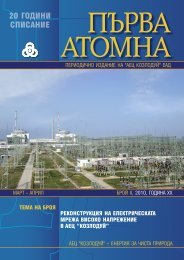Summary Report for Conduct of Kozloduy NPP Stress Tests
Summary Report for Conduct of Kozloduy NPP Stress Tests
Summary Report for Conduct of Kozloduy NPP Stress Tests
Create successful ePaper yourself
Turn your PDF publications into a flip-book with our unique Google optimized e-Paper software.
“<strong>Kozloduy</strong> <strong>NPP</strong>” PLC<br />
SUMMARY REPORT<br />
<strong>for</strong> <strong>Conduct</strong> <strong>of</strong> <strong>Kozloduy</strong> <strong>NPP</strong><br />
<strong>Stress</strong> <strong>Tests</strong><br />
5.2.2 Measures to improve robustness at loss <strong>of</strong> power supply<br />
These systems <strong>for</strong> power supply to the SFP are the same which ensure power supply to units<br />
5 and 6, with exception <strong>of</strong> the additional DG and mobile DG. If the proposal is implemented related<br />
to units 5 and 6, reliability <strong>of</strong> the power supply to the SFP cooldown system will enhance.<br />
5.2.3 Loss <strong>of</strong> ultimate heat sink<br />
At failure to all the trains <strong>of</strong> SFP cooling system, as well as at isolation <strong>of</strong> the containment,<br />
decay heat removal from the stored fuel is provided through pool water steaming. To prevent<br />
impermissible level reduction in fuel compartments and uncoverage <strong>of</strong> the fuel emergency scheme<br />
is used <strong>for</strong> filling through one <strong>of</strong> containment spray system pumps with water from ECCS tanksump.<br />
The pump motor is cooled by service water system <strong>for</strong> cooling <strong>of</strong> safety system consumers.<br />
Response <strong>of</strong> the structure at loss <strong>of</strong> ultimate heat sink is the same, as at loss <strong>of</strong> power<br />
supply, but heat removal stops significantly later – after exhaust <strong>of</strong> emergency water volume from<br />
the cold channel and termination <strong>of</strong> spray pools make-up. Thus durations, analyzed <strong>for</strong> the case <strong>of</strong><br />
complete loss <strong>of</strong> alternate current power supply, specified above, prolong on 197 hours (8.2 days).<br />
A possibility exists to supply service water with the diesel-pumps from the inlet chamber <strong>of</strong><br />
CPS-3 (CPS-4) to the first train <strong>of</strong> service water system <strong>for</strong> cooling <strong>of</strong> safety system consumers.<br />
Scheme is proposed, according to which cooling can be ensured <strong>for</strong> the motors <strong>of</strong> the pumps <strong>of</strong> the<br />
first train <strong>of</strong> the emergency core cooling system. Thus, due to water reserve in the tank-sump,<br />
steaming from SFP may be replenished <strong>for</strong> during 32 h 15 min at the most severe conditions (the<br />
fuel is relocated from the reactor to the SFP).<br />
If boric solution reserve is used in the tanks <strong>of</strong> boron control system, time period during<br />
which loss due to steaming can be compensated <strong>for</strong>, prolongs on at least 19 hours, at this operation<br />
<strong>of</strong> the pumps, used <strong>for</strong> filling, is independent from operation <strong>of</strong> service water system.<br />
5.2.4 Measures to improve robustness to loss <strong>of</strong> ultimate heat sink<br />
The main mean to improve robustness <strong>of</strong> SFP-5 and SFP-6 is to ensure make-up <strong>of</strong> the spray<br />
pools (proposal introduced above in par. 5.1.4.<br />
5.3 SFP OF UNITS 3 AND 4<br />
5.3.1 Loss <strong>of</strong> power supply<br />
5.3.1.1 Loss <strong>of</strong> <strong>of</strong>f-site power supply<br />
5.3.1.1.1 Design schemes at loss <strong>of</strong> <strong>of</strong>f-site power supply, sources, capacity and availability <strong>for</strong><br />
operation <strong>of</strong> emergency power supply<br />
Main and standby power supply<br />
155/202

















